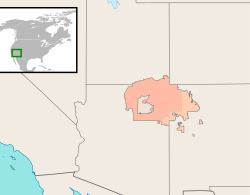Navajo Nation
|
Navajo Nation Naabeehó Bináhásdzo |
|||
|---|---|---|---|
| Reservation | |||
|
|||
| Anthem: (none) ("Dah Naatʼaʼí Sǫʼ bił Sinil" used for some occasions) |
|||
 Location of the Navajo Nation. Checkerboard-area in lighter shade (see text) |
|||
| Established | June 1, 1868 (Treaty) | ||
| Expansions | 1878–2011 | ||
| Chapter system | 1922 | ||
| Tribal Council | 1923 | ||
| Capital | Window Rock (Tségháhoodzání) |
||
| Subdivisions |
5 Agencies
|
||
| Government | |||
| • Body | Navajo Nation Council | ||
| • President | Russell Begaye | ||
| • Vice President | Jonathan M. Nez | ||
| • Speaker of the Navajo Council | Lorenzo Bates | ||
| • Chief Justice of the Navajo Nation | Allen Sloan | ||
| Area | |||
| • Total | 71,000 km2 (27,413 sq mi) | ||
| Population (2010) | |||
| • Total | 173,667 | ||
| • Density | 2.4/km2 (6.3/sq mi) | ||
| 166,826 Navajo/Nat. Am. 3,249 White 3,594 other, incl. multiple |
|||
| Time zone | MST/MDT | ||
| Website | www.navajo-nsn.gov | ||
The Navajo Nation (Navajo: Naabeehó Bináhásdzo) is a semi-autonomous Native American territory covering 27,425 square miles (71,000 km2), occupying portions of northeastern Arizona, southeastern Utah, and northwestern New Mexico in the United States. This is the largest land area retained by a U.S. tribe, with a total population of 173,667.
The original territory has been expanded several times since the 1800s. In 2016 under the Tribal Nations Buy-Back Program, some 149,524 acres of land were returned by the Department of Interior to the Navajo Nation for tribal communal use. The program is intended to help restore the land bases of reservations.
The Navajo Nation has an elected government that includes an executive office, a legislative house, and a judicial system, but the United States federal government continues to assert plenary power over all decisions. The executive system manages a large law enforcement and social services apparatus, health services, Diné College, and other local educational trusts.
The population continues to disproportionately struggle with health problems, unemployment, and the effects of past uranium mining accidents.
In English, the official name for the area was "Navajo Indian Reservation", as outlined in Article II of the 1868 Navajo Treaty. On April 15, 1969, the tribe changed its official name to the Navajo Nation, which is also displayed on the seal. This was a period of Native American activism and assertion of sovereignty. In 1994, the Tribal Council rejected a proposal to change the official designation from "Navajo" to "Diné." It was remarked that the name Diné represented the time of suffering before the Long Walk, and that Navajo is the appropriate designation for the future.
In Navajo, the geographic entity with its legally defined borders is known as "Naabeehó Bináhásdzo". This contrasts with "Diné Bikéyah" and "Naabeehó Bikéyah" for the general idea of "Navajoland".
...
Wikipedia


